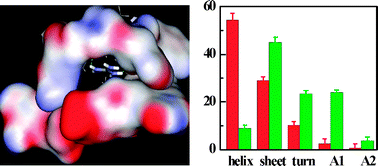Understanding conformation transitions of proteins in the presence of a chemical denaturant is a topic of great interest because the rich information contained in chemical unfolding is of fundamental importance for proteomic and pharmaceutical research. In this work, the conformational structure changes of glucose oxidase (GOx) induced by guanidinium ions (Gdm+) were studied in detail by a combination of electrochemical methods, various spectroscopic techniques including ultraviolet–visible (UV–vis) absorption, fluorescence, Fourier transform infrared (FTIR), and circular dichroism (CD) spectroscopy, molecular dynamics (MD) simulations, and density functional theory (DFT) calculations with the purpose of revealing the mechanism of chemical unfolding of proteins. The results indicated that GOx underwent substantial conformational changes both at the secondary and tertiary structure levels after interacting with Gdm+ ions. The interaction of GOx with the chemical denaturant resulted in a disturbance of the structure of the flavin prosthetic group (FAD moiety) that induced the moiety to become less exposed to solvent than that in the native protein molecule. The calculation from quantitative second-derivative infrared and CD spectra showed that Gdm+ ions induced the conversion of α-helix to β-sheet structures. MD simulations and DFT calculations revealed that Gdm+ ions could enter the active pocket of the GOx molecule and interact with the FAD group, leading to a significant alteration in the structural characteristics and hydrogen bond networks formed between FAD and the surrounding amino acid residues. These alterations in the conformational structure of GOx resulted in a significant decrease in the catalytic activity of the enzyme to glucose oxidation. The study essentially provides an effective way for investigating the mechanism of chemical denaturant-induced protein unfolding, and this approach can be used for assessing the effect of drug molecules on proteins.

You have access to this article
 Please wait while we load your content...
Something went wrong. Try again?
Please wait while we load your content...
Something went wrong. Try again?


 Please wait while we load your content...
Please wait while we load your content...